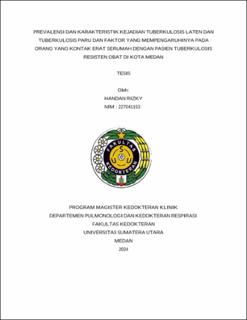Prevalensi dan Karakteristik Kejadian Tuberkulosis Laten dan Tuberkulosis Paru dan Faktor yang Mempengaruhinya pada Orang yang Kontak Erat Serumah dengan Pasien Tuberkulosis Resisten Obat di Kota Medan
Prevalence and Characteristics of Latent Tuberculosis and Pulmonary Tuberculosis Incidence and Its Influencing Factors among People in Close Contact with Drug-Resistant Tuberculosis Patients in Medan City.

Date
2024Author
Rizky, Handan
Advisor(s)
Sinaga, Bintang Yinke Magdalena
Siagian, Parluhutan
Ashar, Taufik
Metadata
Show full item recordAbstract
Background: Latent tuberculosis infection (ILTB) is defined as the presence of
an immune response to Mycobacterium tuberculosis without clinical evidence of
active tuberculosis (TB). Approximately 5-15% of people with ILTB will develop
active TB during their lifetime. The World Health Organization advocates
urgency to address the issue of ILTBI to contain and eliminate the tuberculosis
epidemic. Accelerating the detection of TB disease among high-risk contacts of
MDR-TB patients can maximize the opportunity to identify and treat latent
infection to prevent disease, and should be prioritized to achieve the End
Tuberculosis Strategy.
Objectives: To determine the prevalence and characteristics of Latent TB and
Pulmonary TB in people in close contact with patients with Drug Resistant TB
and analyze the factors that influence it.
Methods: This study is descriptive analytic using a cross-sectional approach in
people who are in close contact with Drug Resistant TB patients in Medan. The
number of samples used was at least 96 research subjects who were in close
contact with patients with DR-TB.
Results: Based on contact investigation on close contact at home with Drug
Resistant TB patients, the most age group was 18-30 years old, namely 30 people
(31%), the most gender was female 71 people (69%), the most education was high
school as many as 63 people (60%), the most occupation as a housewife was 43
people (41%), The normal body mass index was 84 people (81%), did not smoke
81 people (80%), did not consume alcohol 101 people (97%), contact duration ≥5
hours 69 people (67%), length of stay with case index >10 days 97 people (93%),
did not sleep in the same room 73 people (70%), and did not have comorbid
diseases 91 people (87%). There is an association between occupational factors
and the incidence of latent TB compared to the Non-TB Infected group with a
value of (p=0.014) and there is an association between alcohol consumption
factors with the incidence of Pulmonary TB compared to Non-Pulmonary TB with
a value of (p=0.039).
Conclusion: There is an association between occupational factors and the
incidence of latent TB compared to the Non-TB Infected group with and there is
an association between alcohol consumption factors with the incidence of
Pulmonary TB compared to Non-Pulmonary TB.
